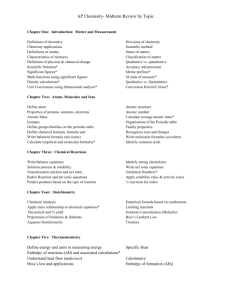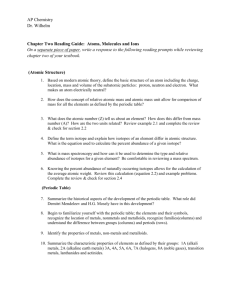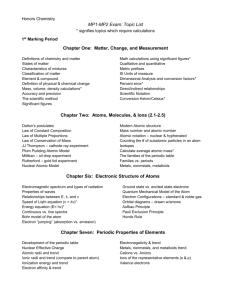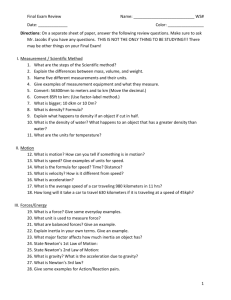121 Outline of Topics May 2014_ZM_v2
advertisement
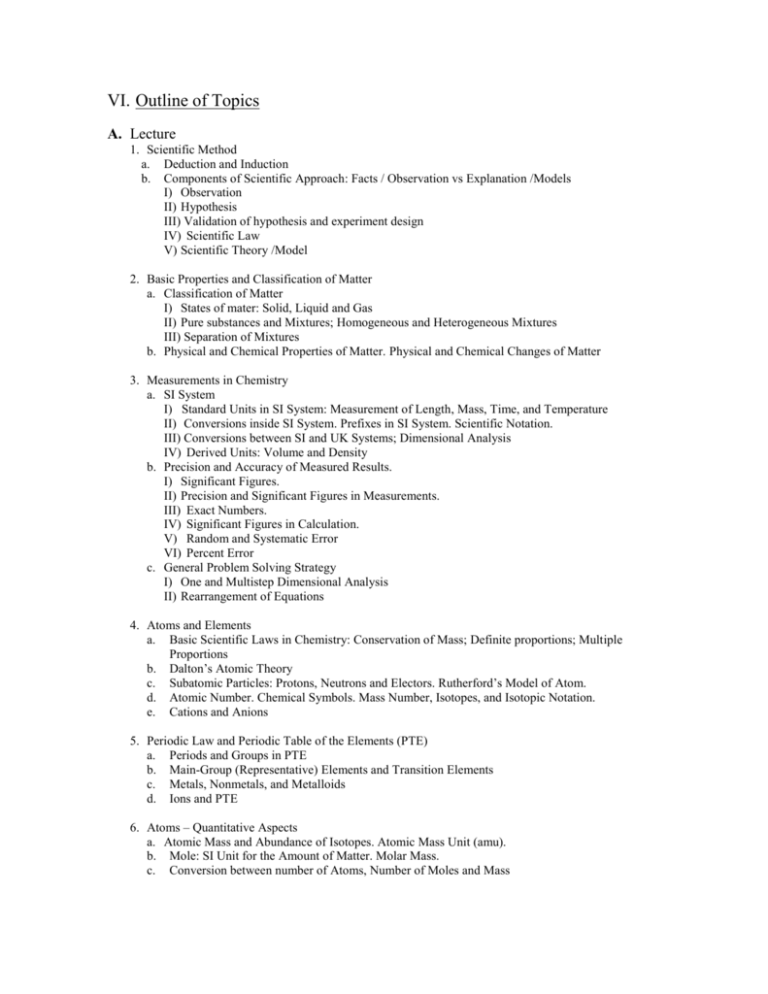
VI. Outline of Topics A. Lecture 1. Scientific Method a. Deduction and Induction b. Components of Scientific Approach: Facts / Observation vs Explanation /Models I) Observation II) Hypothesis III) Validation of hypothesis and experiment design IV) Scientific Law V) Scientific Theory /Model 2. Basic Properties and Classification of Matter a. Classification of Matter I) States of mater: Solid, Liquid and Gas II) Pure substances and Mixtures; Homogeneous and Heterogeneous Mixtures III) Separation of Mixtures b. Physical and Chemical Properties of Matter. Physical and Chemical Changes of Matter 3. Measurements in Chemistry a. SI System I) Standard Units in SI System: Measurement of Length, Mass, Time, and Temperature II) Conversions inside SI System. Prefixes in SI System. Scientific Notation. III) Conversions between SI and UK Systems; Dimensional Analysis IV) Derived Units: Volume and Density b. Precision and Accuracy of Measured Results. I) Significant Figures. II) Precision and Significant Figures in Measurements. III) Exact Numbers. IV) Significant Figures in Calculation. V) Random and Systematic Error VI) Percent Error c. General Problem Solving Strategy I) One and Multistep Dimensional Analysis II) Rearrangement of Equations 4. Atoms and Elements a. Basic Scientific Laws in Chemistry: Conservation of Mass; Definite proportions; Multiple Proportions b. Dalton’s Atomic Theory c. Subatomic Particles: Protons, Neutrons and Electors. Rutherford’s Model of Atom. d. Atomic Number. Chemical Symbols. Mass Number, Isotopes, and Isotopic Notation. e. Cations and Anions 5. Periodic Law and Periodic Table of the Elements (PTE) a. Periods and Groups in PTE b. Main-Group (Representative) Elements and Transition Elements c. Metals, Nonmetals, and Metalloids d. Ions and PTE 6. Atoms – Quantitative Aspects a. Atomic Mass and Abundance of Isotopes. Atomic Mass Unit (amu). b. Mole: SI Unit for the Amount of Matter. Molar Mass. c. Conversion between number of Atoms, Number of Moles and Mass 7. Chemical Compounds and Chemical Formulas a. Ionic and Covalent Compounds b. Chemical Formulas: Empirical, Molecular, Structural, and Three-Dimensional d. Atomic-Level (Nanoscopic) View of Elements and Compounds. Ionic Crystal Lattice and Molecular Models e. Quantitative Aspects of Chemical Formula I) Formula Mass and Molecular Mass II) Molar Mass III)Mass Percent Composition of a Compound and Chemical Formula IV) Empirical and Molecular Formula from Experimental Data. Combustion Analysis. f. Chemical Equations. Balancing Chemical Equations. 8. Nomenclature of Chemical Compounds a. Monoatomic and Polyatomic Anions. b. Metals That Form Only One Type of Cations. g. Metals That Form More Than One Type of Cations h. Ionic Binary and Ternary Compounds including Salts and Bases of both main Group and Transition Metals i. Molecular Binary and Ternary Compounds including oxyacids 9. Stoichiometry – Calculations Based on Balanced Chemical Equations Applying the Mole Concept j. Mole-Mole, Mole-Mass, and Mass-Mass Conversion k. Limiting Reactant, Theoretical Yield, and Percent Yield. 10. Reactions in Aqueous Solution a. Solution Concentration. Molarity b. Molarity in Calculation. Solution Stoichiometry c. Nonelectrolytes and Electrolytes. I) Strong and weak electrolytes II) Strong and Weak Acids d. Solubility of Ionic Compounds. Precipitation Reaction e. Writing Balanced Chemical Equation in Molecular, Complete Ionic, and Net Ionic Formats f. Acid-base (Neutralization) Reactions. Stoichiometry of Acid-Base Titration. g. Gas Evolution Reactions h. Redox Reactions: I) Oxidation Numbers / States II) Identifying redox Reactions III) Half-Reactions of Oxidation and Reduction IV) Oxidizing and Reducing Agent V) Combustion Reactions VI) Balancing Redox Equations by Inspection 11. Gases a. Pressure, Temperature, and Volume. I) Conversions between Common Units of Pressure Temperature and Volume. II) Standard Temperature and Pressure (STP). b. Simple Gas Laws: Boyle’s, Charles’, and Avogadro’s. Absolute Zero Temperature. c. Using Kinetic Molecular Theory (KMT) to Explain Simple Gas Laws and Concept of Absolute Zero. d. Combined Gas Law e. Ideal Gas Law. Ideal Gas Constant. I) Standard Molar Volume of Gases II) Expanded Ideal gas Formula; Density of a Gas; Molar Mass of a Gas f. Partial Pressure of a Gas Mixture. Vapor Pressure. Applying KMT to Explain Partial Pressures Law. g. Stoichiometry of Reactions in Gaseous Phase h. Diffusion and Effusion of Gases; Explanation through KMT. 12. Thermochemistry a. System and Surroundings b. Forms of Energy. Internal Energy of a System. c. Temperature and Heat. First Law of Thermodynamics. d. Heat Capacity; Specific Capacity; Molar Heat Capacity e. Constant Volume Calorimetry – Bomb Calorimeter f. Reaction at Constant Pressure: Enthalpy I) Thermochemical Equations II) Exothermic and Endothermic Processes III) Constant Pressure Calorimetry IV) Standard Enthalpies of Formation V) Hess’ Law 13. Evolution of Modern Atomic Theory a. Wave Nature of Light. I) Amplitude, Wavelength (λ), and Frequency (ν) II) Relationship Between λ and ν. Electromagnetic Spectrum. III) Interference and Difraction b. Particle Nature of Light I) Photoelectric Effect; Photons. II) Relationship Between Energy of a Photon and Wavelength/Frequency of Light III) Dual Nature of Light c. Bohr’s Model of Atom of Hydrogen I) Atomic Spectroscopy and Quantized Orbits of Electrons II) Calculating Energy of an Orbit Using Rydberg’s Constant III) Difference in Energy between Allowed Orbits. Absorption and Emission Spectra 14. Quantum Mechanical Model of Atom a. Dual Nature of Matter and Main Idea of Schrodinger Equation b. Quantum Numbers. c. Atomic Orbitals. Shapes of s, p, and d orbitals. d. Sublevel Energy Splitting in Multielectron Atoms I) Coulomb’s Attraction between Nucleus and Electrons II) Shielding. Effective Nuclear Charge III) Degenerate Atomic Orbitals e. Ground State of Electron Configuration for Multielectron Atoms. Aufbau Principle. Hund’s Rule. 15. Electron Configuration and Periodic Table of the Elements (PTE) a. Core and Valence Electrons b. Relationship between Electron Configuration and the Position of an Element in the PTE I) Electron Configuration from Position in the PTE II) Position of an Element in the PTE from its Electron Configuration III) Analogous Configurations of Valence Energy Level in a Group of PTE and Similarity of Chemical Properties IV) Orbital Blocks in the PTE c. Periodic Properties of the Elements I) Periodic Trends in Atomic Radius and Effective Nuclear Charge II) Periodic Trends in Ionization Energy. First, Second, and Third Ionization Energy. III) Electron Configuration of Ions. Ionic Radii; Relationship between Sizes of Atoms, Anions, and Cations. Magnetic Properties of Ions. IV) Electron Afinity. V) Metallic/Nonmetallic Properties and Position of an Element in PTE 16. Chemical Bonding: Lewis Octet Theory a. b. c. d. e. f. g. Types of Chemical Bonds: Ionic, Covalent, and Metallic Lewis Structures of Atoms and Monoatomic Ions Ionic Compounds I) Lattice Energy: II) Impact of Ion Charge and Ion Size (Culomb’s Attraction). to Lattice Energy III) Melting Point and Crystal Lattice Energy. Covalent Bonding I) Bonding (Shared) and Nonbonding (Shared) Electron Pairs II) Single, Double, and Triple Covalent Bond III) Electronegativity. Polar and Nonpolar Covalent Bonds. Lewis Structures of Molecular Compounds and Polyatomic Ions I) Rules to Write Lewis Structures: Octet Rule II) Resonance III) Formal Charge IV) Exception to the Octet Rule: Odd Electron Species, Incomplete Octet (Electron-Deficit Structures), and Expanded Octets Bond Energy and Bond Length. Estimating Reaction Energies Using Bond Energies. Metallic Bond: Electron Sea Model 17. Molecular Shapes: VSEPR Theory a. Electron Groups. Electron Group Geometry b. Molecular Shape (Geometry); Effect of Lone Pairs. c. Polyatomic Species with More than One Central Atom d. Polar and Nonpolar Molecules: Combined Effect of Bond Polarity and Molecular Shapes/Geometry 18. Valence Bond Theory a. Atomic Orbitals (AO) Overlap. Coordinate Covalent Bond. b. Using Hybridization of AO to Explain Molecular Geometry I) sp, sp2, and sp3 Hybridization II) σ and π bonds; Double and Triple Bonds. III) Delocalized π Electrons IV) sp3d, and sp3d2 Hybridization 19. Molecular Orbital (MO) Theory (Optional) c. Linear Combination of Atomic Orbitals; Bonding and Antibonding MO d. MO Diagrams for Period One and Two Diatomic Molecules and Molecular Ions; Bond Order: Magnetic Properties. 20. Intermolecular Forces and Physical States of Matter a. Relationship between Molecular Polarity and Types of Intermolecular Forces I) Dispersion (London) Forces II) Dipole-Dipole Interactions III) Ion-Dipole Interactions IV)Hydrogen Bonding b. Impact of Intermolecular Forces to Physical State of Matter c. Surface Tension, Viscosity, and Capillary Action d. Vaporization I) Heat of Vaporization. Volatile and Nonvolatile Liquids II) Vapor Pressure; Temperature Dependence of Vapor Pressure; Normal Boiling Point e. Sublimation and Depositions. Heat of Sublimation. f. Fusion. Melting Point. Heat of Fusion. g. Heating Curve h. Phase Diagram: Vaporization, Fusion, and Sublimation Curve; Triple Point; Normal Melting and Boiling Point; Supercritical Temperature and Pressure i. Fundamental Types of Crystal Solids: Molecular Solids, Ionic Solids, Atomic Solids (Nonbonding, Metallic, and Network Covalent) 21. Solutions a. Solubility: Solute-Solvent Intermolecular Interactions; Polarity of Solvent and Solute b. Energetics of Solution Formation; Heat of Hydration c. Factors Affecting Solubility I) Effect of Temperature on Solubility of Solids II) Solubility of Gases: Effect of Temperature and Pressure (Henry’s Law) d. Solution Concentration I)Molarity II) Molality III)Mass Percent; ppm and ppb IV)Mole Fraction and Mole Percent e. Colligative Properties of Solutions of Nonvolatile Nonelectrolytes I)Vapor Pressure Lowering (Raoult’s Law) II) Boiling Point Elevation III) Freezing Point Depression IV)Osmotic Pressure f. Colligative Properties of Electrolyte Solutions (van’t Hoff factor) A. Laboratory Activities. Includes lectures and demonstration of the location and use of laboratory safety equipment as well as the laboratory and safety policies of the college. There are weekly hands-on activities, which may include 13-14 of those listed below. 1. Resolution of Matter into Pure Substances. Paper Chromatography. 2. The Densities of Liquids and Solids 3. Properties of Hydrates 4. Determination of a Chemical Formula 5. The Standardization of a Basic Solution and the Determination of the Molar Mass of an Acid 6. Determination of Iron by Reaction with Permanganate – A Redox Titration 7. Verifying the Absolute Zero of Temperature 8. The “Air-Bag” Problem – Solving an “Actual” Problem Experimentally 9. Heat Effects and Calorimetry 10. The Alkaline Earths and the Halogens – Two Families in the Periodic Table 11. What’s in These Bottles? 12. The Geometrical Structure of Molecules; An Experiment Using Molecular Models 13. Classification of Chemical Substances 14. Molecular Mass Determination by Depression of Freezing Point
